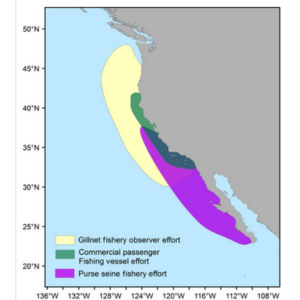We investigate the impact of oceanographic variability on Pacific bluefin tuna (Thunnus orientalis: PBF) distributions in the California Current system using remotely sensed environmental data, and fishery-dependent data from multiple fisheries in a habitat-modeling framework. We examined the effects of local oceanic conditions (sea surface temperature, surface chlorophyll, sea surface height, eddy kinetic energy), as well as large-scale oceanographic phenomena, such as El Niño, on PBF availability to commercial and recreational fishing fleets. Results from generalized additive models showed that warmer temperatures of around 17–21°C with low surface chlorophyll concentrations (<0.5 mg/m3) increased probability of occurrence of PBF in the Commercial Passenger Fishing Vessel and purse seine fisheries. These associations were particularly evident during a recent marine heatwave (the “Blob”). In contrast, PBF were most likely to be encountered on drift gillnet gear in somewhat cooler waters (13–18°C), with moderate chlorophyll concentrations (0.5–1.0 mg/m3). This discrepancy was likely a result of differing spatiotemporal distribution of fishing effort among fleets, as well as the different vertical depths fished by each gear, demonstrating the importance of understanding selectivity when building correlative habitat models. In the future, monitoring and understanding environmentally driven changes in the availability of PBF to commercial and recreational fisheries can contribute to the implementation of ecosystem approaches to fishery management.
Environmental associations of Pacific bluefin tuna (Thunnus orientalis) catch in the California Current system
Publication date
December 26, 2018
Abstract
Journal
Fisheries Oceanography
DOI
https://doi.org/10.1111/fog.12418
Region
California Current


